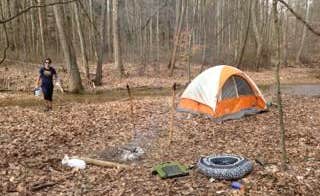Dispersed camping near Radcliff, Kentucky offers primitive outdoor experiences within several undeveloped areas of public land. The region sits at elevations ranging from 400 to 900 feet with a humid subtropical climate featuring warm summers and mild winters. Winter camping can be challenging with average January temperatures around 30°F, while summer heat often exceeds 85°F with high humidity from June through September.
What to do
Hiking with elevation challenges: The Knobstone Trail system provides substantial terrain variations for backpackers seeking physical challenges. According to Susan C., "The entire park is just beautiful. It's very family friendly and quiet. The sites are spacious, and there are a lot of nature things to do." The trail's continuous ups and downs create opportunities for training hikes before tackling larger mountain trails.
Fossil hunting: The limestone geology throughout Knobstone Trail creates excellent fossil-hunting opportunities. As Maris H. notes, "Everywhere you hike there are lovely vistas and lots of fossils on the trail and creek beds." The best hunting occurs after rainfall when creek beds reveal newly exposed specimens.
Astronomy viewing: The minimal light pollution at many dispersed sites creates optimal stargazing conditions. Nighttime darkness is particularly notable at these remote locations. Pack red-light headlamps to preserve night vision when setting up observation equipment.
What campers like
Secluded camping: Remote sites in Hoosier National Forest provide privacy not found at developed campgrounds. According to Nathanyal C., it's a "Big spot for almost any type of camper. Deep woods" with opportunities to camp far from other visitors.
Wilderness preparation: The area serves as training grounds for larger backpacking trips. Dave E. explains, "Most people, even Hoosiers don't realize the Knobstone Trail exists. It's often referred to The Little AT by those who know about it. It's no walk in the park." Many hikers use these trails to build endurance before attempting longer thru-hikes.
Water feature camping: Several sites offer proximity to streams or rivers. Maris H. advises campers on Knobstone, "You're never too far from water, although the quality may differ depending on the time of year." Water availability varies seasonally, with most reliable sources occurring from late winter through spring.
What you should know
Accessibility limitations: Some trailheads require navigation skills to locate. At Jackson Trailhead, loganx11 reports "there's parking after a decrepit gravel road and suitable for camping. there are campsites along the trail just have to find them." Many sites lack clear signage or maintenance.
Navigation requirements: Accurate maps are essential for finding dispersed sites. Desert B. cautions about Knobstone Trail access: "Maybe Google Maps took me to the wrong place (probably not). I drove back and forth on the road several times looking for this place. The only thing I found was what I believe was the entrance with a cable across it."
Seasonal considerations: Tick activity becomes problematic during spring months. Maris H. warns, "Watch out for ticks. My dogs and I got loads of them in April 2020 from Leota to Spurgeon Hollow." Bug repellent containing DEET or permethrin-treated clothing becomes essential equipment from April through October.
Tips for camping with families
Age-appropriate routes: Select shorter trail segments with less elevation change for younger children. Susan C. recommends Knobstone Trail areas for families, noting "It's very family friendly and quiet. The sites are spacious, and there are a lot of nature things to do."
Extra preparedness: Pack additional supplies when bringing children to remote areas. Dave E. cautions about Knobstone Trail, "It's no walk in the park. There are continuous ups and downs that will challenge your leg strength and footing at times." Children require more frequent breaks and additional water on challenging terrain.
Water safety protocols: First Creek Dispersed Camping requires close supervision of children near water features. Shelly S. advises, "There is a beautiful pond/lake at the bottom of the hike that empties into the Green River. Realize of course water = snakes and take precautions." Establish clear boundaries for children near water sources.
Tips from RVers
Vehicle limitations: Most dispersed camping areas near Radcliff accommodate only small trailers or tent camping. Large RVs should avoid these areas completely due to narrow, unpaved access roads and lack of suitable parking.
Alternative campgrounds: RVs should utilize established campgrounds rather than dispersed sites. The access roads described by loganx11 as "decrepit gravel road" at Jackson Trailhead indicate conditions unsuitable for larger vehicles or trailers.
Road preparation: Four-wheel drive vehicles provide the safest access during wet conditions. Many access roads become impassable after heavy rainfall, with several days of dry weather needed before conditions improve enough for safe passage.


